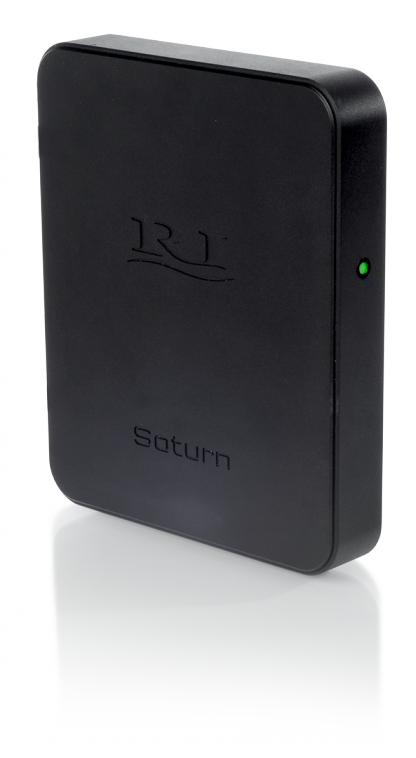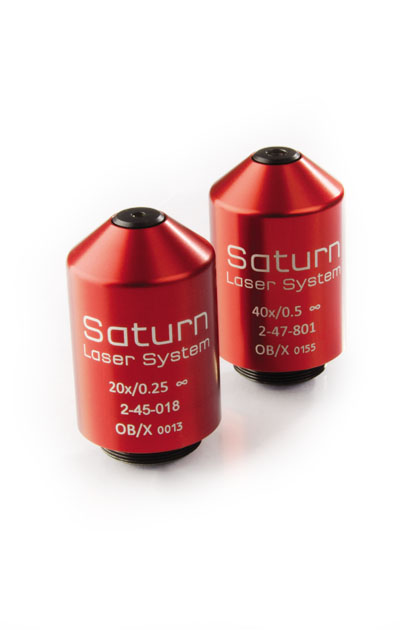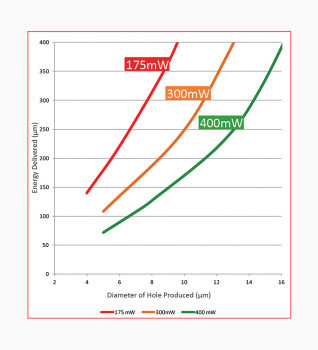Saturn 5TM
Fixed and Directional Laser Systems
As the pioneer of moveable lasers for Assisted Reproductive Technology, the Saturn 5 Active™ laser is spearheading a revolution in hatching and biopsy techniques in laboratories all over the world.
The Saturn 5™ Biopsy Mode is helping you to significantly improve biopsying methods; potentially reducing procedure time, lowering the incidence of blastocyst collapse and eliminating the need to mechanically tear off cells.
Using Biopsy Mode, you can draw a straight or curved line along the sample, select the number and size of holes, then simply “fire”. The laser will ablate exactly along the chosen path, meaning you no longer need to move the holding pipette at all. It is that easy.
This product is available for sale in the U.S.A and selected countries in Europe and the rest of the world.

“We have been using the Saturn 5 Active™ laser system for assisted hatching, blastomere biopsy and blastocyst collapsing since November 2012. The moveable Saturn™ laser means I can ablate the zona exactly where I want to, without having to move the embryo, also the new biopsy mode allows me to accurately make holes in either straight or curved lines along the zona. The new laser system from RI makes the procedures quicker, easier and safer to perform than ever before. We love it!”
Samantha Knight, SPIRE London Fertility Clinic, UK
Saturn 5TM
Fixed and Directional Laser Systems
As the Saturn 5™ pilot laser travels down the same fibre optic path as the ablation laser, it guarantees consistent positioning.
You can calibrate and verify hole size and firing position with accuracy simply and quickly, leaving more time for your procedures.

Key Features
Faster Biopsies
Biopsy mode allows accurate laser drilling along a straight or curved drawn line
Excellent Accuracy
Excellent accuracy and unique computer controlled laser with guaranteed laser alignment
Safest Lasers on the Market
Lowest laser pulse energy for minimal energy near critical cells. Exclusion Zone™ feature ensures cell safety
Intuitive Software
Intuitive RI Viewer software package with streamlined interface. Programmable foot pedal controls software and laser functions including the new biopsy mode
Versatile
Compatible with all popular brands of micromanipulators and inverted microscopes
Saturn 5TM – Totally Committed To Embryo Safety
Multiple safety features reassure you that the Saturn™ laser is the safest laser on the market.
To keep your embryos safe, features include the Exclusion Zone which can be set according to distance or temperature.
By employing a higher laser power, the Saturn™ laser applies less total energy to make a specified hole size, in comparison to lower power laser systems.

Applications*
Using Saturn 5 Active™, you will find the following procedures are almost effortless and can be performed quickly and accurately. These procedures may require difficult embryo manipulation when performed using fixed lasers.
Using a Saturn 5 Active™ has clear advantages to the welfare of the embryo.
Blastomere Biopsy, Polar Body Biopsy, Blastocyst Collapsing (for vitrification)
The Saturn 5 Active™ directional laser allows the embryo to stay in the desired position and focus so that ablations can be made wherever required without additional manipulation. Our Biopsy Mode also allows safe multi-pulse drilling along a predetermined line.
Assisted Hatching
The directional laser means that accurate ablations can be made without the need to hold the embryo, making it very quick and accurate, with no additional consumable costs.
*The applicability of procedures is dependent on the regulations of the country into which the device is sold.
Blastocyst/Trophectoderm Biopsy
The Saturn 5 Active™ is unparalled in its ease of use.
The directional laser allows the user to make multiple ablations across the trophectoderm cells without needing to move the blastocyst.
This gives the user superb accuracy, safety and incredible speed.
ZeissAxio ObserverLeft-hand Motor120×6-47-500-10Saturn 5 Active Zeiss Axio Observer 20x LH Motor
| Microscope Manufacturer | Model | Stage | Objective Choice | Part Number | Description |
|---|---|---|---|---|---|
| Nikon | Ti2 | Integra Ti | 40x | 6-47-500-25 | Saturn 5 Active Nikon Ti2 with Integra 40x |
| Nikon | Ti2 | Nikon XY | 40x | 6-54-500-26 | Saturn 5 Active Nikon Ti2 with Nikon XY Stage 40x |
| Nikon | Ti2 | Integra Ti | 20x | 6-54-500-27 | Saturn 5 Active Nikon Ti2 with Integra 20x |
| Nikon | Ti2 | Nikon XY | 20x | 6-54-500-28 | Saturn 5 Active Nikon Ti2 with Nikon XY Stage 20x |
| Nikon | Ti-S, Ti-U, Ti-E | Integra Ti | 40x | 6-47-500-01 | Saturn 5 Active Nikon Ti with Integra 40x |
| Nikon | Ti-S, Ti-U, Ti-E | Nikon XY | 40x | 6-47-500-02 | Saturn 5 Active Nikon Ti with Nikon XY Stage 40x |
| Nikon | Ti-S, Ti-U, Ti-E | Integra Ti | 20x | 6-47-500-04 | Saturn 5 Active Nikon Ti with Integra 20x |
| Nikon | Ti-S, Ti-U, Ti-E | Nikon XY | 20x | 6-47-500-05 | Saturn 5 Active Nikon Ti with Nikon XY Stage 20x |
| Nikon | TE2000 | Integra Ti | 40x | 6-47-500-19 | Saturn 5 Active Nikon TE2000 with Integra 40x |
| Nikon | TE2000 | Nikon XY | 20x | 6-47-500-20 | Saturn 5 Active Nikon TE2000 with Nikon XY Stage 20x |
| Nikon | TE2000 | Integra Ti | 40x | 6-47-500-21 | Saturn 5 Active Nikon TE2000 with Integra 40x |
| Nikon | TE2000 | Nikon XY | 20x | 6-47-500-22 | Saturn 5 Active Nikon TE2000 with Nikon XY Stage 20x |
| Nikon | TE200, TE300 | – | 40x | 6-47-500-17 | Saturn 5 Active Nikon TE300 40x |
| Nikon | TE200, TE300 | – | 20x | 6-47-500-18 | Saturn 5 Active Nikon TE300 20x |
| Nikon | Diaphot 200/300 | – | 40x | 6-47-500-23 | Saturn 5 Active Nikon Diaphot 200/300 40x |
| Olympus | IX53, IX73, IX83 | – | 40x | 6-47-500-03 | Saturn 5 Active Olympus IX3 40x |
| Olympus | IX53, IX73, IX83 | – | 20x | 6-47-500-06 | Saturn 5 Active Olympus IX3 20x |
| Olympus | IX51, IX71, IX81 | Left-hand Motor1 | 40x | 6-47-500-13 | Saturn 5 Active Olympus IX2 40x LH Motor |
| Olympus | IX51, IX71, IX81 | Left-hand Motor1 | 20x | 6-47-500-14 | Saturn 5 Active Olympus IX2 20x LH Motor |
| Olympus | IX51, IX71, IX81 | Right-hand Motor1 | 40x | 6-47-500-15 | Saturn 5 Active Olympus IX2 40x RH Motor |
| Olympus | IX51, IX71, IX81 | Right-hand Motor1 | 20x | 6-47-500-16 | Saturn 5 Active Olympus IX2 20x RH Motor |
| Olympus | IX50, IX70 | – | 40x | 6-47-500-24 | Saturn 5 Active Olympus IX1 40x |
| Leica | DMi8 | – | 40x | 6-47-500-09 | Saturn 5 Active Leica DMi8 40x |
| Leica | DMi8 | – | 20x | 6-47-500-08 | Saturn 5 Active Leica DMi8 20x |
| Zeiss | Axio Observer | Left-hand Motor1 | 40x | 6-47-500-09 | Saturn 5 Active Zeiss Axio Observer 40x LH Motor |
| Zeiss | Axio Observer | Right-hand Motor1 | 40x | 6-47-500-11 | Saturn 5 Active Zeiss Axio Observer 40x RH Motor |
| Zeiss | Axio Observer | Right-hand Motor1 | 20x | 6-47-500-12 | Saturn 5 Active Zeiss Axio Observer 20x RH Motor |
1Choose left or right according to XY stage handle position. The motor should normally be opposite the stage handle.
Saturn 5 Fixed Selection
NikonTE2000, Ti-40×6-47-501-01Saturn 5 Fixed Nikon TE2000 & Ti 40xLeicaDMi8-40×6-47-501-03Saturn 5 Fixed Leica DMi8 40x
| Microscope Manufacturer | Model | Stage | Objective Choice | Part Number | Description |
|---|---|---|---|---|---|
| Nikon | TE300 | – | 20x | 6-47-501-02 | Saturn 5 Fixed Nikon TE300 40x |
All systems are supplied with four mains cables: UK, EU (CEE 7/7), USA and China/Australia
Q.Why do I need a laser?
A. For Assisted Hatching, Blastomere, Polar Body and Trophectoderm Biopsies – and other procedures, it is necessary to make a hole in the zona pellucida. Using a laser to do this is more precise, safer and quicker1,2 than other methods. You may save a great deal in disposables such as Acid Tyrodes and pipettes, and the laser’s use will potentially reduce the amount of time lab staff spend preparing for and performing procedures2. One other very important factor is that lasers have the potential to standardize laboratory procedures by reducing operator variability, which can be a big problem when, for example, using Acid Tyrodes for Assisted Hatching.
1Research Instruments Ltd, Falmouth, UK, (2012). A comparison of different power levels used by laser systems in the IVF laboratory.
2Lloyd S, Doshi A, Harper J, (2013). A new method of biopsying trophectoderm (TE) cells using the latest Saturn 5™ Laser System, offers several potential ways to improve procedures.
Q.What are the advantages of using the Saturn 5 laser?
A. The Saturn 5 Active laser can be directed to the target location, eliminating the need to move the embryo, which can be difficult and time-consuming. It has a visible pilot laser to ensure the laser is aligned to the objective (so that “flaring” of the laser beam does not occur) and to check the position of the laser when required. It has a high power and ultra-short pulse time combination to make the most energy-efficient holes with minimal heat transfer. Saturn 5 laser systems use shorter pulse times than any competitor system. They also come with a sophisticated software package – RI Viewer™ – to record images and data for both lab and patient use.
Q.Why do I need a pilot laser?
A. The pilot laser ensures the laser is not going to flare or spread heat where it is not required. Microscopes also have a number of moving parts which could affect the position of the laser such as the nosepiece, camera and port selector. The only way to be certain of the laser’s position is to check it before firing. Using a pilot laser that travels down the same fibre-optic as the main laser guarantees the position and reduces the need for additional service visits. RI lasers are calibrated to within 1µm accuracy.
Q.What is the difference between the Saturn pilot laser and other red spot targeting systems?
A. Misalignment between the pilot laser and the infrared laser is not possible using a Saturn laser as the two travel down the same fibre-optic cable. Other systems have to be separately aligned. Shape and focus quality of the Saturn laser can be checked. This is not possible with other systems.
Q. Other lasers can adjust the power as well as the pulse length. Isn’t this an advantage?
A. Research shows that the most efficient way to deliver laser energy is to use pulse length to control the hole size1. Doing this ensures the lowest amount of heat reaches the embryo, thereby lowering possible risk of thermal damage. Other laser systems do not allow the user to vary the power in clinical use, only in a non-clinical evaluation mode.
Q. Isn’t a higher powered laser dangerous for the user?
A. Our lasers are Class 1 (the safest level), as defined by IEC 60825 international laser safety standards, so no special safety precautions are required. We also fit an infrared filter to prevent any laser energy reaching the operator as an extra safety measure.
Q. How do I know the laser beam is not damaging the embryo?
A. We have worked with embryologists to assess the damage to embryos at different pulse lengths and at varying distances from critical cells. Based on the results of the study3 we developed a visual “Exclusion Zone™” around the laser target which is a measuring tool that informs the user where the heat is applied, relative to critical cells. This is more clinically relevant than providing a temperature, as the latter is entirely theoretical, leaving the embryologist with a problem in deciding what temperature is safe.
3Chatzimeletiou K, Morrison E E, Panagiotidis Y, Prapas N, Prapas Y, Rutherford A J, Grudzinskas G, Handyside A H, (2005). Comparison of effects of zona drilling by non-contact infrared laser or acid Tyrodes on the development of human biopsied embryos as revealed by blastomere viability, cytoskeletal analysis and molecular cytogenetics, Reproductive BioMedicine Online, Vol 11. No 6. 2005 697–710.
Q. I have been told that an off-axis laser cannot focus properly. Is this true?
A. This only applies to a simple lens. The Saturn 5 Active objective is a complex compound lens which is corrected for astigmatism, so the laser is focused correctly everywhere in its range of movement. This is easily demonstrated by looking at the pilot laser diffraction rings as the beam is moved. Any focus error would be obvious as the ring pattern would visibly change. Furthermore, it has always been a routine requirement that all parts of the field of view are in sharp focus. The same is true for the laser.
Q. Is the alignment of the laser difficult?
A. No. Initial alignment is carried out once at installation. The laser position should be checked before each procedure, and this takes two seconds. A full calibration can be done from time-to-time to ensure optimal alignment and this takes 30 seconds. This is a very simple procedure and worthwhile, to minimize damaging the embryo.
Q. Can I transfer the laser to another microscope?
A. Yes, if it is the same model of microscope. If it is a different model then most parts can be transferred, but a different mirror module will be required. Use the fibre cleaning kit 6-46-590 for installation.
Q. Can I upgrade my Saturn 3 to a Saturn 5?
A. Yes, the Saturn 3 and Saturn 3 Active can be upgraded to Saturn 5 or Saturn 5 Active with the purchase of parts.
Q.For how long will Saturn 3 and Saturn 3 Active parts be manufactured?
A. We will offer service support for Saturn 3 lasers while-ever parts are in stock. However, we cannot guarantee parts availability from November 2019 onwards.
Q.How long is the warranty and expected life-span of the laser?
A. Our warranty is one year from despatch of goods. The system is designed to work reliably for many years.
Q.Do you provide technical support in terms of service and repairs?
A. It is very important that your equipment is working properly. If a part needs replacing, under usual circumstances, we can send replacements in one or two working days. Our service team and distributors can repair equipment and carry out routine servicing annually, or as required.

